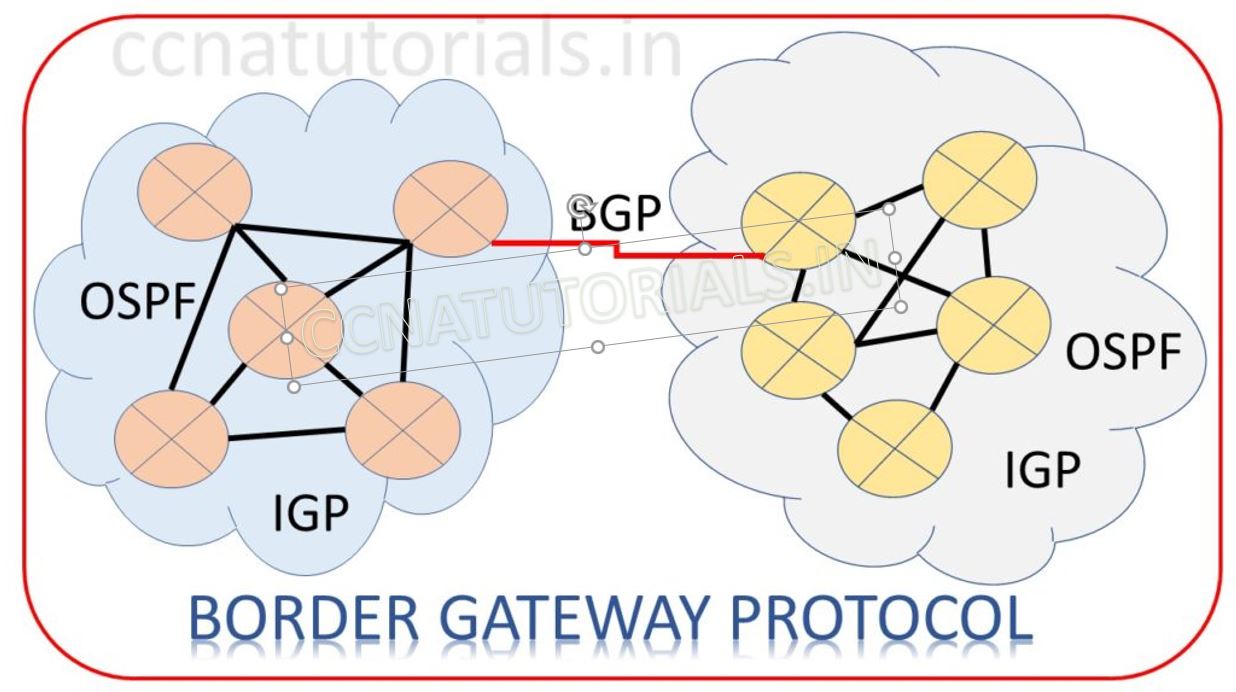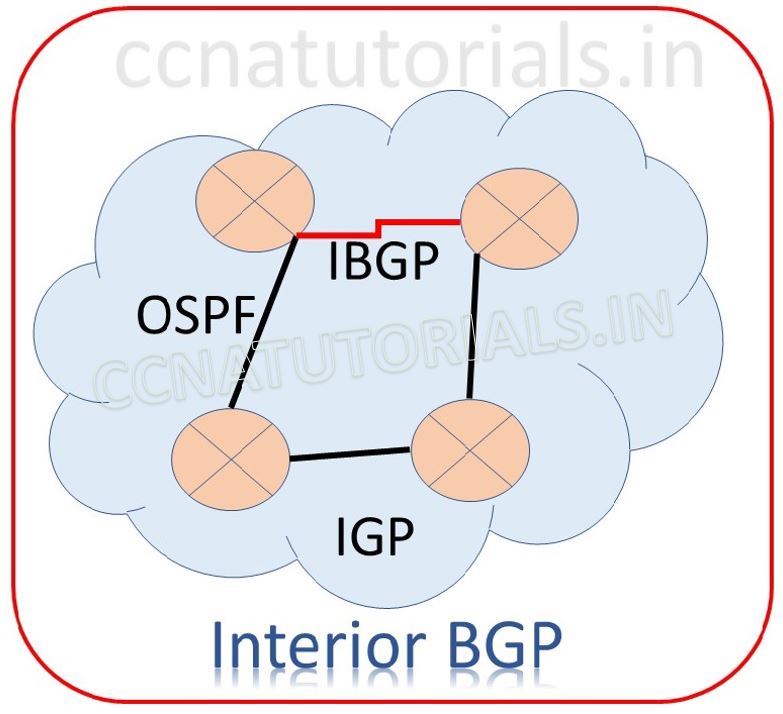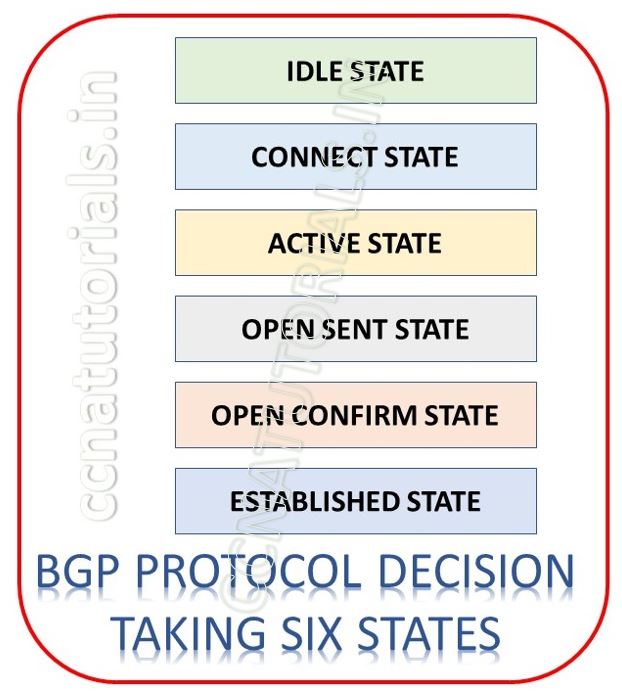Contents of this article
In this article I describe the BGP Protocol tutorial in computer network for CCNA exam. BGP Protocol is related to application layer of TCP/IP Suite model. The BGP protocol works on the edge routers on internet. BGP forward the packets between different AS (Autonomous Systems). BGP provides the connectivity between different AS for data packets flow from one network to another network. The BGP protocol is reliable so if any one link of router goes down. BGP protocol reinstates the communication from another link of the edge router. A standard routing table is maintained by the edge routers for data packet flow between different AS.
Before going to learn about BGP Protocol tutorial we need to remember the OSI suite and TCP/IP suite model. There are many manufacturer of computer machine in the market. Initially when computers became single user public computer. The computers communicate with only same brand machines. It happens because there was no any fix standard for data transfer between different devices. It is very difficult to make communication with each other when the hardware are of different brands or company. In this article I describe the some basic part of OSI reference layer and TCP/IP Suite model basic concepts in networking with the BGP protocol.
OSI reference model in computer network followed by various vendors to overcome the compatibility problem. After implementation of OSI reference model in computer network, equality maintains by all manufacturer. In 1970 the Open Systems Interconnection (OSI) reference model was created by the International Organization for Standardization (ISO). The OSI model was meant to create inter-operable network with different manufactured devices. In this article I describe some layered approach of TCP/IP Suite model basic concepts in computer network. Before understanding the TCP/IP Suite model basic concepts it is necessary to know about the 7 layers of OSI reference model because the basic work of each layer is described in the OSI reference model. You can read the full article related to OSI reference model in computer networking here.
Importance of OSI reference model for BGP Protocol tutorial
Before going to know about the BGP Protocol tutorial. It is necessary to know the function of application layer in OSI model and TCP/IP model. Initially not only hardware but software also not supported for work the different computer brand. It became very difficult for all computer users to working without implementation of OSI reference model in computer network. It is necessary then to make some common protocols for all vendors of computer. Before implementation of OSI reference model in computer network, all vendors implements their own protocols on computer hardware and software.
In networking OSI reference model became helpful. OSI reference model describes the flow of data between nodes in any network. Data from one computer application to another computer application transfer by following some common protocols. The OSI reference layer also become beneficial for troubleshooting the network problems. TCP/IP and Cisco three layered hierarchical model of Cisco became more helpful alongside the OSI reference model.
The Layered Approach in computer network for BGP Protocol tutorial.
The Layered approach was the best way to make equality for all computer devices. Layers are not physical but following some protocols. Protocols are for connectivity, connections, data transfer and more. All manufacturer begin to follow the layered approach for OSI reference model in computer network. The OSI reference model change in TCP/IP reference model and later on Cisco three layered hierarchical model. OSI layer architecture have 7 layers. TCP/IP reference model convert these 7 layers into only four layers. After that Cisco three layered hierarchical model converts these 7 layers into three layers. Some layers combined to work in a single layer.
OSI is acronym for open system interconnection. The OSI is a logical reference OSI reference model in computer network. OSI model helps for data flow between different devices and operating systems. All manufacturer used their own architecture before invention of OSI reference model. It was very difficult to establish data communication between different devices. To overcome this problem international organization for standardization (ISO) created the open systems interconnection (OSI) reference model. OSI reference model make data flow possible between different operating system, devices and hardware. Later the OSI model adopted by Cisco as Cisco three layered hierarchical model.
Structure of OSI reference model related to BGP Protocol tutorial
OSI reference model in computer network consist of 7 layers. These 7 layers further divided into two groups. First 3 layers works for application communication and remaining 4 layers works for data flow. Application, presentation and session layers define the application communication. Transport, network, data link and physical layers define the data flow. Networking protocols works only on last four layers.
TCP/IP Suite model basic concepts for BGP Protocol tutorial
TCP/IP is acronym for Transmission Control Protocol/Internet Protocol (TCP/IP suite model). In this section of the article I describe about TCP/IP suite model basic concepts in detail. TCP/IP suite model is a reference model like OSI layers. Instead of 7 layers of OSI reference model. TCP/IP suite model consist only four layer. All seven layers are merged into four layers only. TCP/IP suite model was designed and implemented by Department of Defence (DoD). TCP/IP developed to preserve data integrity. The main purpose to develop the TCP/IP is to provide security in the network. A lots of protocols works on each layer to provide a secure network.
It is necessary to understood the protocols used in TCP/IP Suite model basic concepts. IP addressing play an important role in TCP/IP Suite model basic concepts. By using the IP address and subnet masking broadcast domain breaks. It will improve the performance of the network. Breaking broadcast domain increase the data flow speed. Here IP stands for IPV4 only. We ignore the IPV6 for some time in this article. It will make it easy to understand the TCP/IP Suite model basic concepts.
A snap of TCP/IP Suite model basic concepts
In the decade of 1970’s TCP/IP suite model developed by DoD. In the initial stage TCP/IP suite model divided into two segments TCP and IP. Later its name registered with combined name of TCP and IP like TCP/IP model. ARPA, the Advanced Research Projects Agency of DoD officially authorised to use TCP/IP suite model. TCP/IP model was working well so it was adopted by many organisations. In today scenario it is mostly using reference model for networking. Internet is the best example of using TCP/IP.
Basic Idea of Layers of TCP/IP Suite model

There are four layers in DoD model. As shown in above image. Top 3 layers of OSI combined and create the Process/Application layer. Transport layer remain Transport layer. Network layer become internet layer and last two layer combined and called link layer. You can see both model are similar in concept.
Process or Application layer of DoD model in TCP/IP Suite model

This is the first layer of TCP/IP of DoD model. It is combination of top three layers of OSI reference model. The functions of Application layer, presentation layer and session layer in OSI model works in single layer process layer. This layer supports the point to point communication and controls the user interface. The data encryption and decryption also done at this layer. Example of some protocols functions at this layer are Telnet, FTP, LPD, TFTP, SMTP.
Transport layer of DoD model in TCP/IP Suite model

Transport layer of TCP/IP is same as the Transport layer of OSI reference model. It supports the TCP and UDP protocol. This protocol converts the main data segment into packets and transport to the internet layer. The responsibility of Transport layer is to combine the segments and built the data. The data should be reconstruct in its real form. Transport layer is also responsible for creating end-to-end communication between sender and receiver. This layer ensure the delivery of segment in sequence at the receiving device. This property maintains the data integrity.
Internet layer of DoD model in TCP/IP Suite model

Internet layer of TCP/IP is similar to the network layer of OSI reference model. Routing protocols functions on Internet layer of TCP/IP model. Addressing and filtering of packets is main responsibility of Internet layer of TCP/IP model. This layer provides the transmission of packet in the whole network. Some example of protocols functions on internet layer are ICMP, ARP and IP.
Link layer of DoD model in TCP/IP Suite model

Link layer is the least layer of TCP/IP. Basically link layer is combination of data link and physical layer of OSI reference model. Link layer is also known as Network Access layer. It works on MAC address based data transmission. Link layer handles the frame and bits. It receive the bits and constructs frame from merging bits in a sequence. In case of any bit is missing this layer request to re transmit the bits. Ethernet, FDDI, WAP etc functions on this layer. There is no any preset specification for link layer. Link layer functions on any type of existing media.
BGP Protocol tutorial
I hope you understood the basics of OSI and TCP/IP suite model in above section of this article. BGP is an application layer protocol. The term BGP stands for Border Gateway Protocol. BGP protocol is an exterior gateway protocol. The BGP protocol responsible for exchange routing among the autonomous systems (AS). The current version of BGP protocol is BGP4. BGP supports the ClDR (Classless Inter Domain Routing). BGP protocol supports both IPv4 and IPv6 address types in computer networking. The BGP peers create the TCP session on port 179. BGP protocol managed by manual configuration. BGP is the protocol which is responsible for working of internet. The BGP helps to transport the data from one AS to another AS.

Function of BGP protocol
Autonomous Systems (AS) is a network controlled by a single Internet Service Provider. BGP runs between two routers for exchange routing configuration. BGP runs between different autonomous systems. IBGP is a type of BGP which runs within same autonomous system (AS). EBGP stands for Exterior Border Gateway Protocol and it runs with different autonomous system. EBGP protocol works between the edges routers of autonomous systems. VPN tunnelling is also done by using EBGP protocol. BGP works like a signalling protocol to transport the routers information in VPN.

Two routers that have established connection for exchanging BGP information, are referred to as BGP peers. These peers transport the information over TCP protocol.
States used by BGP protocol

BGP make decisions by using finite state machine six states. Idle, Connect, Active, Open Sent, Open Confirm and Established are the six states uses by BGP . In Idle state all resources initialize, all protocols reset, and services restarted. Second state is connect state. In connect state the router completes the TCP connection. After successful completion of TCP connection, Open Sent state starts. If the TCP connection doesn’t successful, the router starts Connect Retry and transition to Active state. In Open Sent state the router sends packets and wait for response. After getting the acknowledgement of sent packet router set to Open Confirm state. This is the second last state. After its router set to established state. In final established state routers are in real time communication state. The routers can now send and receive packets from their peer routers.
Function of BGP in router connectivity with each other.
BGP works on two options RFC 4456 and RFC 5065. RFC 4456 called route reflectors and RFC 5065 known as BGP confederations. A BGP router accept NLRI (Network Layer Reachability Information) from the neighbours and transmit the own NLRI to the same peer. BGP maintains its own routing table known as Loc-RIB (Local Routing Information Base). The BGP process creates and manage a adj-RIB-In (adjacent routing information base incoming). Adj-RIB-In contains the NLRI received from the peer router. This process is done in each router’s table which is working on BGP .
A given BGP router may accept Network Layer Reachability Information (NLRI) UPDATEs from multiple neighbours and advertise NLRI to the same, or a different set, of neighbours. Conceptually, BGP maintains its own “master” routing table, called the Local Routing Information Base (Loc-RIB), separate from the main routing table of the router. For each neighbour, the BGP process maintains a conceptual Adjacent Routing Information Base, Incoming (Adj-RIB-In) containing the NLRI received from the neighbour, and a conceptual Adj-RIB-Out (Outgoing) for NLRI to be sent to the neighbour.
In this article I describe the BGP protocol tutorials for CCNA Exam. I hope you found this article helpful. For any query or suggestions on this topic you may drop a comment below or contact us. Your suggestions are always welcome by us.






